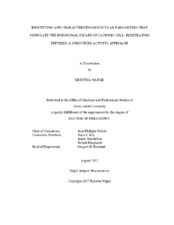Identifying and Characterizing Molecular Parameters that Modulate the Endosomal Escape of Cationic Cell- Penetrating Peptides: A Structure Activity Approach
Abstract
For over 20 years, cell-penetrating peptides (CPPs) have been used as delivery vectors transporting macromolecules (cargos) into live cells for cell biology manipulations and therapeutic applications. While the exact mechanism of cell penetration remains controversial, it is thought that CPPs are first internalized inside endocytic vesicles and have been reported to escape to the cytosolic space of cells. However, while the internalization of CPPs inside vesicles has proven to be highly efficient, their endosomal escape activity remains suboptimal and poorly understood. This is a severe limitation of the CPP-mediated delivery approach because the macromolecules’ escape is essential if the cargo is to interact with its cytosolic/nuclear targets. Multiple approaches to enhance CPP’s endosomolytic activity have been explored (summarized in Chapter 1). Multivalency has been proposed as a possible new approach, in which multiple copies of a molecule are attached as one functional unit. It has been hypothesized that the use of multivalent CPPs will result in an increase in their local concentration at the membrane; and as a consequence enhance their membrane disruption property.
In Chapter 2, I report on the generation of a multivalent CPP: dfTAT, a dimeric version of the most studied CPP, TAT. Similar to TAT, dfTAT enters cells via macropinocytosis. Interestingly, while monomeric TAT is extremely inefficient at escaping the endocytic pathway, I demonstrate that dfTAT escapes endosomes with an unprecedented level of efficiency. Cytosolic penetration of dfTAT can be achieved in multiple cell lines and primary cells, without impacting the cell’s physiology. Most importantly, dfTAT can efficiently deliver a wide variety of macromolecules and cell-impermeable small molecules efficiently into the cytosolic space of live cells.
In Chapter 3, I report on the role that chirality and protease-resistance have on the endosomal escape behavior of dfTAT. By inverting dfTAT’s chirality from L to D stereochemistry, I generated a protease-resistant dfTAT (D-dfTAT). Interestingly, I show that while the mechanism of cellular entry remains the same, D-dfTAT’s cellular internalization is substantially lower than dfTAT. Nonetheless, once in the endosome, DdfTAT escapes with a higher efficiency than its L-counterpart. Finally, while dfTAT treatment is relatively innocuous to cells, D-dfTAT unexpectedly exerted a prolonged anti-proliferative activity.
The literature underscores the important role that arginine residues play in CPP cellular internalization. However, due to the low endosomolytic activity of most CPPs, residues vital for endosomal escape have not yet been established. In Chapter 4, I determined that the arginine residues are both necessary and sufficient for dfTAT endosomolytic activity. Interestingly, a minimum number of 12 arginine residues is required for sufficient endosomal escape.
Overall, this work identifies a novel endosomolytic agent and identifies some of the molecular features important for cellular permeation. In turn, my results lay the foundation for new and optimized versions of the dfTAT prototype that may find applications in a variety of delivery approaches.
Citation
Najjar, Kristina (2017). Identifying and Characterizing Molecular Parameters that Modulate the Endosomal Escape of Cationic Cell- Penetrating Peptides: A Structure Activity Approach. Doctoral dissertation, Texas A & M University. Available electronically from https : / /hdl .handle .net /1969 .1 /165896.


